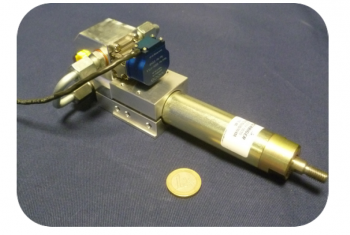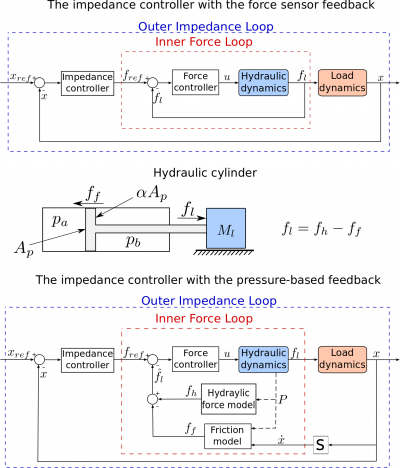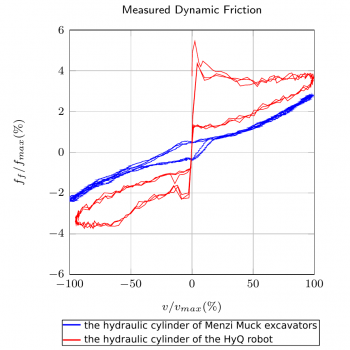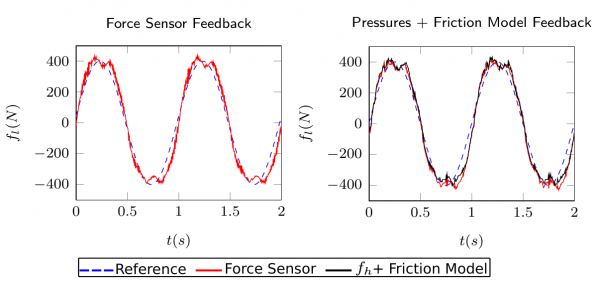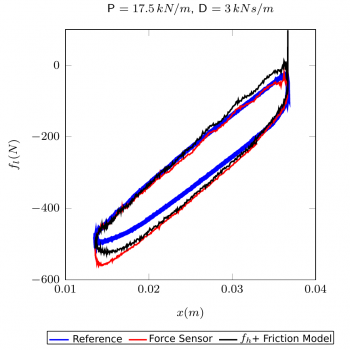Sidebar
<latex>{\fontsize{16pt}\selectfont \textbf{Pressure-based Hydraulic Impedance
Control}} </latex>
<latex>{\fontsize{12pt}\selectfont \textbf{[Stefan Stev\v{s}i\'{c}]}} </latex>
<latex>{\fontsize{10pt}\selectfont \textit{[Master Project RSC]}} </latex>
<latex> {\fontsize{12pt}\selectfont \textbf{Abstract} </latex>
Impedance control is a control concept that focuses on control of interaction. It is used in various robotic applications such as interaction with various environments, with humans, when handling tools etc. Examples are walking robots interacting with unknown terrains or excavators positioning themselves on uneven ground. For this project two impedance controllers were implemented for two hydraulic actuation systems: an actuation system used for the hydraulically-actuated quadruped robot HyQ1) and the actuation system of Menzi Muck excavators. In order to achieve impedance control with the hydraulic actuation system, a load force feedback is usually necessary. In majority of applications a force sensor is used for obtaining the load force feedback. Since the hydraulic actuation system is used, the force can be estimated from the pressure measurements. This enables usage of pressure sensors which are less expensive and more mechanically robust compared to the force sensors. One of the main problems in this process is obtaining a reliable estimate of the friction force inside the hydraulic cylinder. This work proposes one of the friction force models available in literature for purpose of the friction force estimation. Also, the impedance controller design that uses the pressure-based feedback is suggested. The results have shown that pressure-based impedance control is possible for both systems.
<latex> {\fontsize{12pt}\selectfont \textbf{Hardware} </latex>
A two substantially different hydraulic actuations systems were used. The first one is the actuation system used on the HyQ robot of the small size and the very fast response. This system can produce the maximal force of a 3000 N and has the very small hydraulic cylinder with just 8 cm stroke length. The second one is the actuation system used on the Menzi Muck excavator which is much bigger, can produce very large forces, but drastically slower. This actuation system can produce the maximal force of a 200 kN and has the hydraulic cylinder with a 36 cm stroke length.
<latex> {\fontsize{12pt}\selectfont \textbf{Controller Design} </latex>
As the base for the controllers developed in this project, the HyQ robot impedance controller 2) was used. The inner loop of the controller regulates the force and the outer loop gives the force reference based on the position feedback. The desired impedance of the end effector is set through the gains of the outer controller. The reference from this controller is passed to the inner force controller. The force controller needs to have a very fast response in order to obtain the satisfactory performance of the impedance controller.
The pressure-base impedance controller was designed simply by changing the feedback loop of the inner force controller. The load force $ f_l $ measured by the force sensor is resulting force of a hydraulic force $f_h$ inside cylinder and a friction force $f_f$ between the cylinder body and the cylinder piston. Therefore, the load force can be obtained using the estimations of other two forces. The hydraulic force can be obtained from a very simple model using pressure measurements. Contrary, the friction force model needs to be very complex in order to get precise estimate of the friction force. Changing of the feedback does not influence the force controller itself, which is beneficial since the force controller can be designed independently.
<latex> {\fontsize{12pt}\selectfont \textbf{The Friction Force Modelling} </latex>
The friction force is a highly nonlinear phenomena. In case of the hydraulic cylinder, it depends on the cylinder piston velocity and acceleration and also on the pressures inside the hydraulic cylinder chambers. The most used model nowadays is a Stribeck curve friction model, but it accurately describes only the steady state of the friction force. The friction force dynamics is very complex and it highly depends on the velocity dynamics of the bodies in contact . Therefore, to accurately describe the friction force, the complex friction model 3) was used. In cases when the piston velocitiy is constant, this model can be simplified to the Stribeck curve model. It can be said that this model adds some features to the Stribeck curve model, to adapt it for the cases where the dynamic motion occurs.
To use the friction model, a 23 model parameters need to be identified in advance. This is not an easy task, since the friction force depends on several variables and the influence of the single variable is not easy to separate. A good design of experiments enables easier identification of the parameters. The experiment designed for the purpose of identifying the Stribeck curve related parameters, identified a 16 out of the 23 model parameters. Other parameters were identified using the separate experiment for each parameter or by manual adjustment.
The friction force inside the hydraulic cylinder used on the HyQ robot showed a very nonlinear behavior. Contrary, the friction force identified inside the hydraulic cylinder used on Menzi Muck excavators has relatively small nonlinearities, compared to the maximal force that hydraulic actuation system can produce. This enabled usage of a very simple viscous friction model in the case of the Menzi Muck actuation system. Both friction models showed very satisfactory performance in friction model tests and in application on the impedance controller. The main drawback of the friction model used on the hydraulic cylinder from the HyQ robot was inaccurate estimation of the friction force in the cases when the velocity of the cylinder piston was zero or close to zero.
<latex> {\fontsize{12pt}\selectfont \textbf{The Controller Performance} </latex>
The project goal was to show that the proposed concept of the pressure-based feedback works on the impedance controller. The aim was not to improve the impedance controller. The main modification of the impedance controller was in the inner force control loop. Therefore, the force controller was intensively tested. For the hydraulic actuation system of the HyQ robot, a feedback linearization force controller was used. The hydraulic actuation system of Menzi Muck excavators used a much simpler controller: PI with the velocity compensation. Both of these controllers where examined with the pressure based feedback.
The force controller of the hydraulic actuation system of the HyQ robot that used the pressure-based feedback had a very similar performance compared to the cases when the force sensor feedback was used. However, the estimation of the load force degraded when the cylinder piston velocity was zero or close to the zero. This is a consequence of the bad performance of the friction force model on these velocities. Using the friction force model in the model based feedback, introduced oscillatory motions at the steady state of the force controller. This problem was solved by introducing a simple friction model modification. However, the load force estimation error was not completely removed.
The hydraulic actuation system of Menzi Muck excavators used a much simpler friction model. Thus, the force controller implemented was directly tested for the model based feedback. The estimated load force showed very satisfactory matching the real load force. The performance of the force controller was tested and the satisfactory performance was obtained only for the slow velocity dynamics of the cylinder piston. Although the performance was not satisfactory in all of the cases, this is not directly related to the pressure-based feedback.
Several tests were done to show the possibility of using the proposed concept on the impedance controller. Results show that the similar performance was obtained with both feedbacks in the case of the hydraulic actuation system of the HyQ robot. On the hydraulic actuation system of Menzi Muck excavators only the model based feedback was tested. In all of the tests good matching between the estimated load force and the measured load force was obtained. However, the impedance controller performance was only satisfactory in cases when the dynamics of the piston perturbations was slow.
<latex> {\fontsize{12pt}\selectfont \textbf{Conclusion} </latex>
It is possible to model the friction force inside hydraulic cylinders with the relatively high accuracy. The friction force is highly nonlinear phenomena. Therefore, the identification procedure is extremely important for obtaining the precise model. However, with the proposed model, the high accuracy was not obtained at the velocities near zero. This is a consequence of the friction force nature at low velocities and the equipment used for measuring the cylinder piston velocity.
Using the pressure based feedback gives relatively reliable estimate of the load force. Thus, the impedance controller, as well as the force controller, that used the pressure based feedback gave very similar performance to the cases when the force sensor feedback was used. The main drawback of the proposed method was noticed on the controller implemented on the the hydraulic actuation system of the HyQ robot. At velocities of the cylinder piston near zero the estimation of the load force shows a degradation in the performance. This is consequence of the friction force model used.
Comparing the results obtained from two hydraulic actuation systems, the friction modeling was simpler on the actuation system of Menzi Muck excavators. Looking at the relative values, the friction force nonlinearities are smaller as the cylinder diameter rises. Thus, the modeling task of the friction force becomes easier. If possible, the hydraulic cylinders with small nonlinearities in the friction force should be preferred. Otherwise, the complex friction model needs to be used.

